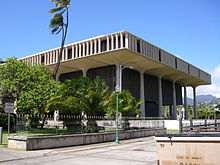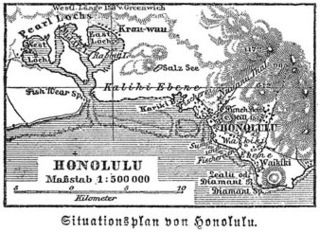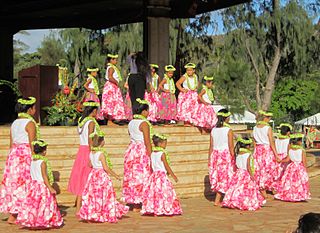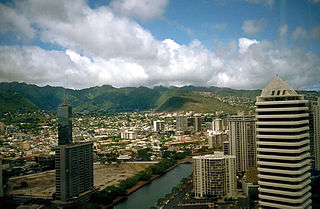Honolulu
![]()
Manoa is a redirect to this article. For other meanings, see Manoa (disambiguation).
![]()
This article is about the capital of the US state of Hawaii; for other meanings, see Honolulu (disambiguation).
Honolulu (in older German literature also: Honoruru) is the capital of the U.S. state of Hawaii and is located on the southern coast of the island of Oʻahu. It is one of the largest cities in the Pacific and the most populous Census-designated place in the United States. Almost every foreign tourist lands here at the Pacific's largest air hub. Honolulu's Waikīkī district, with its exposed oceanfront location and enormous hotel capacity, is an attractive tourist destination.
In the Hawaiian language, Honolulu means "protected bay."
In a 2018 ranking of cities by quality of life, Honolulu ranked 36th among 231 cities surveyed worldwide and third within the United States.
History
It is unknown when Honolulu was first settled or the name first used, but oral histories indicate that the area was first settled by Polynesians in the 12th century. The town's harbor is also called "Kulolia" or "Ke Awa O Kou." The first European to reach Honolulu was British Captain William Brown in his ship Butterworth; he arrived in 1794 and named the harbor "Fair Haven." Other foreigners called it "Brown's Harbour." Honolulu quickly became Hawaii's largest port. At that time, the trade in the wood of the sandalwood tree was significant. Furthermore, Honolulu was an important supply point for whalers. In 1845 Kamehameha III. Honolulu the capital of the Kingdom of Hawai'i. It was also the capital of the Republic and Territory of Hawaii and is still the capital of the US state of Hawaii today.
Ten structures and sites in Honolulu have National Historic Landmark status, including Pearl Harbor, the ʻIolani Palace, and the shipwreck of the USSArizona. 103 structures and sites in the city are listed on the National Register of Historic Places (NRHP) as of November 2, 2018.

Hawaii State Capitol, seat of state government

USS Arizona Memorial by night (2006)
Geography
East of Honolulu rises the 232 m high Diamond Head, made of tuff. The mountain is the landmark of the city.
City breakdown
Honolulu is divided into 5 districts:
- Downtown Honolulu: This district is home to the island's most important government and commercial buildings. It is also the political and economic center of Honolulu. Many museums and attractions are located there. The most important government buildings are the State Capitol, Washington Place and City Hall. The historic Old Town is also home to the statue of King Kamehameha I and the ʻIolani Palace.
- Waikīkī: Waikiki lies directly on the sea and is framed in the north by the Ala Wai Canal. To the east is the Diamond Head crater. Mainly hotels, restaurants and bars are located in the district.
- Manoa Makiki: The district borders Downtown Honolulu to the north and the terrain is more mountainous. The high point of the landscape is the extinct Punchbowl Crater. Manoa Makiki is home to the University of Hawaiʻi at Mānoa. Barack Obama grew up in this area.
- Eastern Honolulu: This region features many sandy beaches and rocky shorelines. It consists of five residential areas and extends to the southeastern tip of Oʻahu. To the west are Waikiki and Diamond Head.
- Western Honolulu: The airport is located in this district. It consists of three residential areas. The famous military port Pearl Harbor is located here.
Climate
The climate of Honolulu is tropical with dry summers (April to September) and some rain in winter (October to March). However, one cannot speak of a rainy season. The number of hours of sunshine is consistently high throughout the year, as is the temperature. The maximum temperature is between 26.7 and 31.5 degrees throughout the year, the lowest temperature is between 18.6 and 23.4 degrees. Even though Honolulu is in the tropics, hurricanes are very rare. The water temperature at the beaches of Honolulu is also constantly warm throughout the year and is at least 24 degrees even in winter.
| Monthly average temperatures and precipitation for Honolulu
Source: ; wetterkontor.de | ||||||||||||||||||||||||||||||||||||||||||||||||||||||||||||||||||||||||||||||||||||||||||||||||||||||||||||||||||||||||||||||||||||||||||||||||||||||||||||||||||||||||||||||||||||||||||||||||||||||||||||||||||||||||||||||||||||||||||||||||||||||||||||||||||||||||||||||||||||||||||

Historical map (around 1888)

Hula dancers in Kapiʻolani Park

View over Honolulu, inland
Search within the encyclopedia